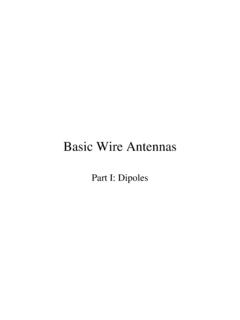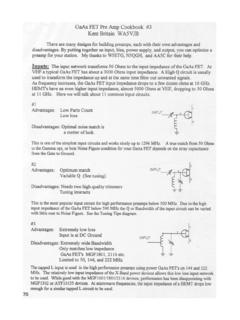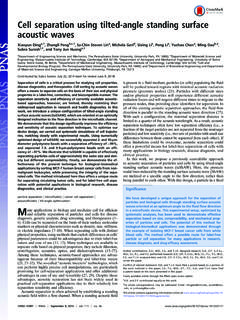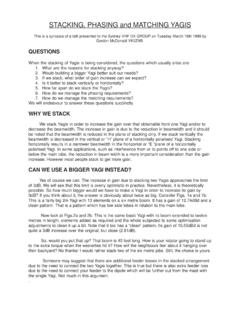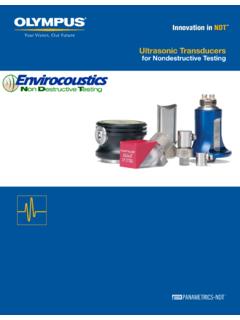Transcription of Chapter 1 Scattering parameters (S- parameters)
1 Chapter 1. Scattering parameters (S- parameters ). Vector Network Analysis opens up completely new perspectives of measurement, which to the user of a scalar network ana- lyzer remain closed. That user sees only the measurement of the amount of a signal (magnitude) on a measurement object content (device under test [DUT]). In contrast the vector network analysis gives additionally a wide insight into the frequency- dependent resistance and phase behavior. It is based on the application of the so-called S- parameters ( Scattering parameters ).
2 The following relationships are shown partially simplified. The vector network analyser (VNWA) sends a known magnitude wave to the input of the measurement object (DUT). In the case of any mismatch (based on 50 Ohms), the VNWA will measure the reflected part of the magnitude and also the phase shift between the emitted and the reflected wave (Figure ). Overall, it is a reflection measurement (S-parameter: S11). If the DUT has only a single connection (example: antenna), it is called a 1-port. On a 1-port only a reflection measurement is possible!
3 This represents the classic matching measurement. If the object to be measured (DUT) has an input, and also an output (examples: amplifiers, filters, phasing lines), then it is called a 2-port. Often of first interest in a 2-port is, how large the magnitude of the output signal versus the input signal is . gain or a desired attenuation, respectively. In other cases, one would like to know the phase shift of the output signal relative to the input signal - such as when measuring a phase-shifting line or the making of two long lines electrically exactly equal.
4 This is all done with a so-called thru (transmis- sion) measurement (S-parameter: S21). Figure presents the measurement of the S-parameter S21 idealized. But the reverse is also possible: The VNWA can feed a wave into the DUT output, and measure what fraction of magnitude comes out of the input. This measurement shows the feedback of the output by the DUT circuit on the input (S-parameter: S 12), Figure On a 2-port, reflection measurements are also possible. They show the existing adjustment (based on 50 ohms) each at the in- put (S-parameter: S11) and output (S-parameter: S22) of the DUT (see Figure ).
5 Here it is important, that the unused port has a correct impedance connected. That is, terminated with the reference impedance, usually 50 ohms. Furthermore, measurement objects can have one input and two outputs or two inputs and one output (examples: power divider, power combiner, antenna switch). This is a 3-port - Figure and Figure (for reasons of clarity a two part presentation is selected). As already noted for the 2-port, for the 3-port all unused ports must have always a correct impedance connected! Below is the summary of the S- parameters for 1- port, 2- port and 3- port measurements: Figure : Reflection measurement on a 1-port; the classic Figure : With a thru (transmission) measurement you can matching measurement.
6 Make gain-/attenuation- and phase-measurements. (Eingang = Input, Schaltung = Circuit) (Eingang = Input, Ausgang = Output, Schaltung = Circuit). 9. Chapter 5. Contexts and Concepts TX Out, RX In, Port 1, Port 2;. S-Parameter Test Set Definitions TX Out, RX In, Port 1, Port 2. This Chapter first has some definitions and explanations which concern the correlations of different S-parameter measurements and the different ways of connecting the necessary VNWA2/VNWA3 to the DUT with proper understanding. They also pro- vide the necessary basis for Chapter 6.
7 The interest of VNWA3 beginners usually grows after a short time, in addition to the initial S 11- and S21-measurements, to take advantage of the S22- and S12-measurement capabilities. This is only possible on a simple VNWA2/VNWA3, with the manual exchanging of the TX-Out and the RX-In terminals of the measured object, and additionally the measured Forward and Reverse direction has to be switched. This effort is annoying and inconvenient, and it also does not allow the rapid assessment of the two directions of measurement - how to improve the matching, for example, of a bandpass filter with the (almost) simultaneous observation of the input and output impedances (S- parameters S11, S22).
8 An S-parameter test set which satisfies such requirements, will be presented in the second part of this Chapter . Firstly, the paths of the measurement signal and other characteristics of S 11-, S22-, S21- and S12-measurements are taken into account: - The S11-measurement is a reflection measurement. Only the TX -Out test lead goes from VNWA2/VNWA3 to the input of the DUT, which is called Port 1 (Figure A). S11-measurement measures into the input of the measuring object; measuring the Figure (left) Paths of the measurement signal and the neces- sary connections in an S11-measurement of (A) a 1-port DUT, (B).
9 And (C) a 2-port DUT. (Eingang = Input). (Ausgang = Output). Figure (top): The Black Box includes the VNWA3 and the S- parameter test set. The left port belongs to port 1 of the meas- urement object, the right connection to the port 2 of the meas- urement object! All else is controlled by the VNWA software. (Leitung = Line). 22. Chapter 14. Measuring Phase Angle As noted in Chapter 4, the major advantage of a Vector network analyser over a Scalar network analyzer, lies in the possibility of phase angle measurement. It is for example necessary for a line within which a well-defined phase rotation is to take place - as is the case in the 180 phasing line for a dipole feed.
10 Also, creating a right- or left- handed circular polarization with linearly polarized antennas requires a defined phase shift between the participating antennae. This is also possible with a line length calculation and has been practiced for decades, but the better is always the enemy of the good ! Once one or more coaxial transfer relays are inserted in such a system (such as in a switchbox for different polarization planes), they also add to the cable lengths and must be considered in the crucial 90 phasing lines. The higher the operating frequency, the larger is the phase angle for a given length (see Chapter 4, Phase), whereby the thing is trickier!
